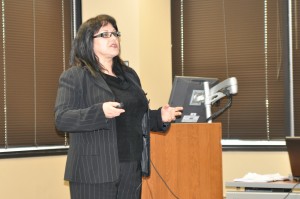From passive to proactive, condition monitoring gives rig operators advance warning of failures
By Katie Mazerov, contributing editor

As rigs and oilfield equipment are increasingly deployed to remote locations and equipped with complex electronic engines and control systems, the risks of failure, unplanned shutdowns and downtime are posing increasing challenges as well. “Fifty years ago, we were dealing with mechanical engines, and we really didn’t have to do anything with them. We just ran them until they died,” said Sepideh Otmishi, product application specialist for Caterpillar’s Global Petroleum division, a provider of electronic data and condition monitoring services for rigs worldwide. “But now, with electric engines and equipment more complicated than ever, we have a tremendous amount of data to manage.”
That, combined with pressure to increase productivity and a changing work force, has pushed the industry to develop more sophisticated systems for condition monitoring (CM).
Speaking at the IADC Rig Condition Monitoring Workshop on 19 January in Houston, Ms Otmishi discussed the benefits of CM, specifically how electronic data can be used to offset engine and equipment challenges for rig operators. It is a more comprehensive process than health monitoring, which provides the current condition of equipment in real time with visual graphics but offers no analysis or indication of potential failures.
“CM is a proactive analysis process using equipment and application data from multiple sources to make critical maintenance, component replacement and repair decisions,” she said. “Our vision is to provide customers with an end-to-end solution by delivering actionable data that can be used to create an informed decision to reduce the cost of repairs and downtime, and increase productivity.”
Advance warning
At Caterpillar, CM involves five elements: electronic data, fluid analysis, site condition, equipment history and regular inspections. Benefits are reduced cost of parts and labor; greater availability and uptime of critical equipment such as compressors, generators and transmissions; and less collateral damage associated with unforeseen failures. “In gathering the information and analyzing and aggregating the data, by the end of the day we can tell you if something is going to fail,” Ms Otmishi said. “We correct emerging problems and move unscheduled repairs to scheduled shutdowns.”
The 24/7 monitoring process detects anomalies and abnormal signals by simultaneously looking at multiple parameters, allowing specialists to provide recommendations for checking assets long before problems are apparent. “The point is, we can provide advance warning of a problem days in advance, not a few hours in advance – which would defeat the purpose of CM,” Ms Otmishi noted. “We give the customer enough time to actually fix, inspect, replace and repair the situation when it is convenient.”
In one case on a Canadian work site, a signal indicated the air-restriction parameter on a piece of equipment was inconsistent and running significantly lower than required. Caterpillar informed the customer and advised an inspection, which revealed a broken air filter tube that was allowing dirt and debris into the air system. Within two days, the item was repaired and the system was back online with no unexpected shutdowns and no downtime.




